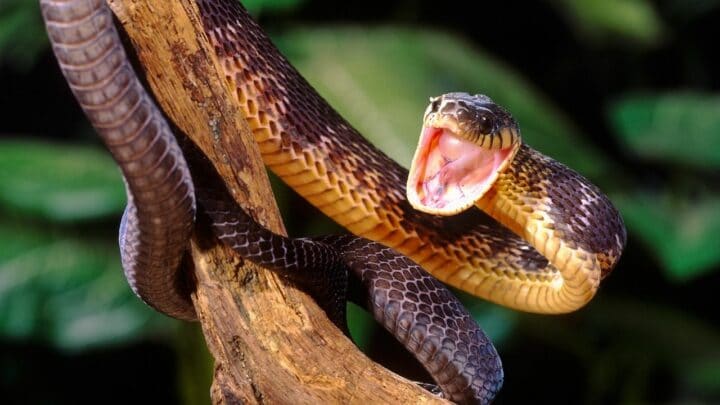Are you taking care of a pet snake? Do you watch what they eat?
It is possible for snakes to be overweight, even obese, especially those in captivity or held as pets. The truth is, the same health problems that afflict humans with excess weight can impact snakes, too.
Snake husbandry includes recognizing when your snake is overweight — and doing something about it.
Concerned your snake is gaining weight? Keep reading to learn why this can be a problem.
Is My Snake Overweight?
Snakes that eat too much gain weight and may become overweight or obese. Indicators that a snake’s overweight include visible signs like its scales spreading, elevated back, love handles, and feeling soft and squishy.
Signs of an Overweight Snake
Do you know the signs and indicators of an overweight snake? It may seem difficult to tell, but familiarity with the snake and the breed can help you pinpoint a weight issue with a snake.
Sure, some snakes may appear fuller and larger than others, but unless you have experience with the species, you may not recognize when a snake is overweight or obese.
Spreading Scales
If your snake is overweight, its scales will be spread apart, stretched, and you will see the skin beneath.
A snake at a healthy weight does not have exposed skin around its scales.
Elevated Back
When your snake is overweight, you will notice a lift or rise of the spine along the snake’s back.
This rise may resemble a bulge in some overweight snakes, similar to what a pregnant snake can look like.
Love Handles
Owners and snake enthusiasts may notice love handles or rolls on their snake when coiled, particularly when wrapped around the handler’s arm.
Soft and Squishy
Typically, your snake is firm and muscular to the touch, but an overweight snake will feel soft and squishy, which should be a telltale sign of weight gain to anyone who is familiar with the snake.
There are exceptions to these indicators, including pregnant snakes and snakes that are naturally larger breeds.
Pregnant snakes can exhibit all the same symptoms of being overweight, plus usually have some visible bumps.
Some breeds like the Hognose snake are inherently bulkier with spreading scales- even at their healthy weight range.
Health Problems for Overweight Snakes
So, your snake is overweight — what is the big deal? The truth is that the same health problems that plague overweight humans can afflict an overweight or obese snake.
Plus, these consequential conditions can significantly impact and shorten the snake’s life expectancy. This is why it is important to have a reliable vet provider to consult with.
First, an overweight snake may have clogged arteries which can lead to a wide range of health repercussions like heart disease.
Furthermore, obese snakes are at higher risk of kidney and liver problems than a snake that is at a healthy weight.
Talk to a veterinarian with expertise in treating reptiles to learn husbandry tips that can help you address your snake’s weight issue in practical, easy ways that yield results.
With some attention to diet and activity level, owners can get their snakes back to a healthy weight in no time!
Frequently Asked Questions about your Snake being Overweight
Why do snakes gain weight?
Snakes gain weight is too much food and not enough physical activity. Some snake breeds are more prone to be overweight due to a sedentary lifestyle, such as pythons and boa constrictors. Corn snakes are the most unlikely to be overweight or obese due to their high energy and activity levels.
Is it unhealthy for a snake to be overweight?
It is unhealthy for a snake to be overweight, just as it is unhealthy for a human. The excess weight can shorten the snake’s lifespan, causing issues with arteries, heart, kidneys, and liver. Some issues afflicting overweight snakes may be reversed with diet and lifestyle changes.
What are signs that a corn snake is overweight?
Corn snakes are least likely to be overweight due to their high-energy personalities, but an overweight corn snake typically exhibits bulges near their hip region. Aptly named, Corn snake hips’ only occurs with this breed of snake.
Can a snake be underweight?
A snake that does not eat enough can be underweight. This is indicated by the snake’s shape, particularly along its spine and back. Handling your pet snake is a good way to determine if it is underweight. Your exotic pet vet will also be able to identify a healthy weight for your snake.
How does an underweight snake look like?
The signs of an underweight snake include a lean shape and a visible spine. The snake takes on a triangular shape due to the protrusion of the spine, which normally appears more rounded and spherical among snakes at healthy weights. The protrusion of ribs is another sign of an underweight snake.
Conclusion
Know the signs of an overweight — or underweight — snake and adjust their diet accordingly.
Since there are serious health issues related to snakes carrying too much weight, it makes sense to cut back on food and try to encourage more activity to help them shed the excess.


